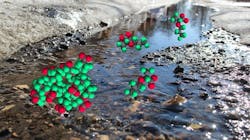Study: How GenX chemicals interact with water
Last fall, the U.S. Environmental Protection Agency reported that GenX chemicals were more toxic than the perfluoroalkyl and polyfluoroalkyl substances (PFAS) that they were developed to replace. Now, a new University at Buffalo-led study examines what happens when GenX — chemicals used in food packaging, nonstick coating and other products — interacts with water.
Published in January in the Journal of Hazardous Materials, the research reveals how molecules of GenX and water intermingle to form complex structures called micelles.
The work builds upon a growing body of scientific evidence suggesting that GenX and its derivatives, which have been found in drinking water in North Carolina and elsewhere, could pose similar or worse health hazards than other PFAS.
“To the best of our knowledge, this is the first study to report on GenX micelles,” says lead author Paschalis Alexandridis, PhD, UB Distinguished Professor in the Department of Chemical and Biological Engineering. “It’s an important step toward better understanding what happens to these chemicals when they are released into the environment.”
GenX is named after a processing technology developed by DuPont in 2009. It is a member of the large group of synthetic chemical compounds known as PFAS.
PFAS are so resistant to breaking down that they are commonly referred to as forever chemicals. They have emerged as a major concern due to their persistence in the environment and their adverse effects on human health and wildlife.
“Many of the more notorious PFAS have been banned,” says Alexandridis. “Industry has developed replacements, presumed to be safer and more sustainable. However, that may not be the case, as findings from the EPA suggest.”
GenX is a surfactant molecule comprising segments that are water-soluble and segments that are not. This dual nature prompts several GenX molecules to self-assemble into micelles, and also to adsorb on surfaces and bind to other compounds such as proteins.
The study, conducted in collaboration with the University of Utah, shows in atom-level resolution the formation and structure of GenX micelles.
Micelles are relevant to the impact that PFAS surfactants, such as GenX, have on the environment and human health, Alexandridis says.
“PFAS are typically found in water and in blood at very low concentrations, but they tend to associate and accumulate at interfaces and surfaces,” he says. “This is desirable when we want to sequester PFAS using adsorbent materials. But it’s not desirable when PFAS bind to proteins in blood or to cell membranes. Hence, it is important to understand and control the PFAS association.”
In addition to improving the scientific community’s understanding of GenX, the study is important, Alexandridis says, because it establishes a methodology to computationally predict how other, lesser-known PFAS behave in similar situations. The study uses a variety of experimental techniques such as surface tension, fluorescence, viscosity, small-angle neutron scattering (SANS), and molecular dynamics simulations.
Alexandridis notes that “We should invest the time and resources to screen such chemicals before we introduce them into products and the environment, where humans and wildlife are exposed to them.”
